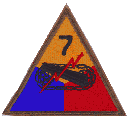

|
The 7th Armored Division and attached units in the St. Vith salient -- the "fortified goose egg" -- held for several days in December 1944. But because they were almost completely surrounded, there were no reinforcements. German forces 5 or 10 times greater attacked over and over, reducing the number of defenders with every attack. With such attrition of men and supplies and no hope of more and in fact the great likelihood of the one narrow exit route being closed by the enemy, the 7th Armored Division defense began to fail on 21 December 1944 when German forces first penetrated southeast of St. Vith and took the town later that night. This forced the easternmost defenders to fall back to the vicinity of Neundorf and Crombach on the night of 21-22 December. On 22 December, German forces north of Rodt (French: Sart-lez-St Vith) swept west and then southeast toward the defenders north of Rodt, pushing them back to Hinderhausen, just north of Crombach, so that the defenders to the north at Poteau could no longer withdraw to the south but only to the west. Thus, many 7AD and attached units were compressed into the area of Neundorf, Crombach and Hinderhausen on 22 December 1944. And the situtation on that day was in great flux. All of the defenders of the salient successfully withdrew under fire west across the Salm River the following day, 23 December. Thanks to careful planning and frozen ground, they suffered relatively few casualties during the withdrawal, despite the much larger German forces attacking on their heels from multiple directions. In January 1945, 7th Armored Division retook St. Vith. And Graves Registration units followed, recovering the remains of those who had been killed during the December 1944 defense but whose remains had to be abandoned in the face of the very strong enemy attack. In some cases, the Germans had collected remains and buried them - either in foxholes or rough graves. The Graves Registration unit that recovered remains from the vicinity of Crombach apparently used the town as a temporary base for the operation. In some cases, they carefully noted the coordinates where remains were recovered; in others they did not. And in almost all of the cases, the Report of Burial at the temporary U. S. Military Cemetery at Henri-Chapelle, Belgium, simply gave their place of death as Crombach, even when specific coordinates placed the recovery half a mile or more away from town. The result is that it is very difficult to tell just what happened on 22 December 1944 and where and how those who were killed suffered their fate. This makes it very difficult to determine what may have happened to those soldiers killed that day whose remains have never been recovered and identified. This web page brings together the records of all of those thus far known as recovered from the vicinity of Crombach and those still unaccounted who died in the area at that time. The hope is that by compiling all of these records in one place, a better understanding can lead to hope for finding the remains of those still unaccounted, as well as providing the families of those men killed with some idea of what happened in their soldier's final hours. September 2024 UPDATE: This page has been dormant since 3 Oct 2016 due to my health problems and forced moves and other priorities. Even now, it is not going to receive full attention, but at least it is active for the first time in 8 years with the addition of the link to the page on "Probable GIs Buried as German Unknowns". Back in 2015 and 2016 when I was working on this, I discovered that a U. S. Graves Registration Service man had also been killed when the Germans overran the recovery point. Unfortunately, I cannot find the name of that man. Even though he was not in 7AD, he was there and deserves to be included on this page. My primary focus in September 2024 is on the Probable GIs Buried as German Unknowns. In processing the IDPFs in that effort, my current conception of the recovery of remains from the area north of Rodt is this that the remains were recovered in separate events.
|
|
While there will be maps for specific soldiers or groups, this section brings together the various maps of the overall area and the routes of withdrawal for troops on the eastern perimeter and the northern perimeter of the St. Vith Salient. |
|
This list is very much incomplete. At this point (see St Vith Known Dead), I have identified 67 soldiers of 7th Armored Division who died 22 December 1944. Some of them have never been recovered and identified. So this list will grow slowly as I deal with specific soldiers. But it is a long way from being complete right now. The list is by battalion/squadron and alphabetically within that. Note that any referenced PDFs are those of Individual Deceased Personnel Files (IDPFs) of those killed. The PDF files for these men are in the image files for their battalion/squadron in the 7th Armored Division Document Repository's images files. |
|
Active overview of all pages at the 7th Armored Division web site